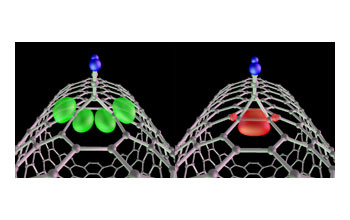Multimedia Gallery
Manipulating Carbon Nanotubes
Manipulating Carbon Nanotubes. Massachusetts Institute of Technology researchers have discovered that certain molecules can attach themselves to metallic carbon nanotubes without interfering with their exceptional conducting properties. Key to this property is the ability of cycloaddition fictionalizations to preserve the graphitic bonding environment even after covalent attachment. The molecular orbitals involved in the high conductance state are shown in the left panel (green). Some molecules can even switch between the highly conductive tautomer and a poorly conductive one, where the sidewall carbons revert to sp3 hybridization (right panel, red). Such properties could lead to applications in sensing, imaging or light amplification. This research was supported by National Science Foundation grants DMR 03-04019 and DMR 04-14849. (Date of Image: September 2006)
SORRY: THIS IMAGE IS NOT AVAILABLE IN HIGH-RESOLUTION FORMAT
Credit: Image courtesy Marzari Lab (http://quasiamore.mit.edu)
Images and other media in the National Science Foundation Multimedia Gallery are available for use in print and electronic material by NSF employees, members of the media, university staff, teachers and the general public. All media in the gallery are intended for personal, educational and nonprofit/non-commercial use only.
Images credited to the National Science Foundation, a federal agency, are in the public domain. The images were created by employees of the United States Government as part of their official duties or prepared by contractors as "works for hire" for NSF. You may freely use NSF-credited images and, at your discretion, credit NSF with a "Courtesy: National Science Foundation" notation.
Additional information about general usage can be found in Conditions.
Also Available:
Download the high-resolution TIF version of the image. (3.3 MB)
Use your mouse to right-click (Mac users may need to Ctrl-click) the link above and choose the option that will save the file or target to your computer.



